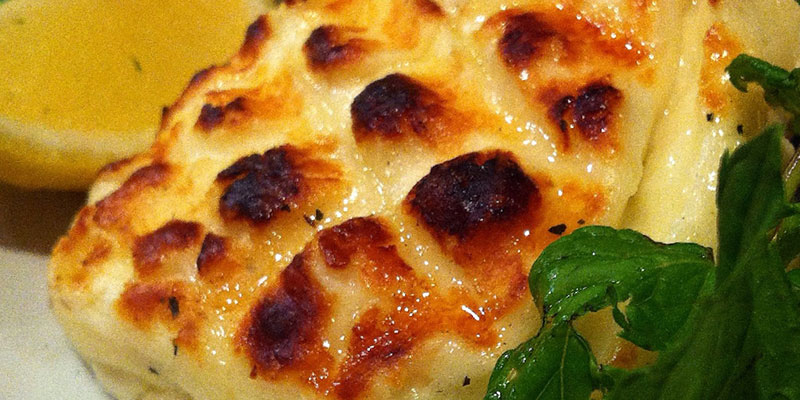Cypriot Grilled Halloumi
Halloumi is a versatile cheese that can be eaten cold, thin slices tucked into a simple tomato sandwich turn an otherwise average lunch into something remarkable. Its’ flavor is overwhelmingly salty with a touch of mint, mellowing out the mix of cow’s and sheep’s milk that is the base of this fresh cheese. It can also be cured in its own brine, developing a nutty flavor and hardening considerably, similar to a pecorino. Halloumi can be eaten right after it is made or within weeks of its production, packed in water much like mozzarella. The cheese is formed into small, rectangular pieces with fresh mint and then folded over onto itself, enclosing the mint inside that infuses the resulting brick of halloumi.

Nowadays, halloumi is Cyprus’ number one food export (just edging out red-soil potatoes) that can be readily found worldwide in most specialty food retailers and in larger grocery chains, far away from the little island where it is produced. This was not always the case. There was a time when this unique cheese couldn’t be found off the island, so Ioanna’s mother would send back with us what seemed like a year’s supply during our graduate school years. The cheese was frozen successfully until we ate through our supply and returned to Cyprus for the summers. Quite by accident, I discovered how good this cheese when, forced to defrost it quickly, I had to boil it. Ever eaten the rind of parmigiano that has been cooked in with risotto? Hot halloumi is even better.
The cheese’s exuberance when heated is its’ strength. Its’ texture is more dense than creamy mozzarella, so it is actually the perfect cheese for grilling, holding up well to intense heat without losing its’ structure. When heated, the cheese softens but doesn’t become stringy; it doesn’t actually melt, similar to parmigiano. Grilling halloumi is best when cooked whole; as the exterior caramelizes and crisps, the interior softens. If cut into thick slices, the cheese tends to toughen over the intense heat of the grill and gets leathery, destroying it’s unique texture.
Let’s just say that anyone who has ever tried grilled halloumi right off the grill is an instant fan. It’s that good.
Grilled Halloumi
serves 8-12, depending on thickness
Place on a platter:
- 3 bricks fresh halloumi
- sprigs of mint
- 1 lemon, quartered
Prepare your myGrill™ Chef SMART™ grill. Spread the heated wood charcoal in a thin layer over the heating tiles and fit the stainless steel racks to the grill. Slide the racks over the prepared wood coals. Place the halloumi to the side of the grill closest to you, so that one of the four points of the halloumi is facing toward you, like a compass.

STEP ONE
Grill for 5-7 minutes , lifting the sides up with tongs every couple of minutes, being careful not to turn the pieces. During the last minute, make sure you can still lift up the cheese. You can check this by the developing color of the halloumi, which should just be starting to turn golden brown for the first turn. Remember this side will cook again.
STEP TWO
Using the tines of a fork, gently but quickly pry the halloumi away from you. Flip the piece of halloumi, making a quarter turn, so that the S point becomes the W point of the compass. You can check this as the cooked side with the grill marks will be perpendicular to the direction of the grates of the grill. This is done so you will end up with a crisscross pattern on the finished halloumi. Grill for 5-7 minutes as in STEP ONE.
STEP THREE
Flip the halloumi over without making a turn and cook for 3-4 minutes, lifting up the piece gently to make sure it has not melted excessively and stuck to the grates. Be careful at this stage not to over-brown the halloumi. As the cheese heats it goes from golden brown to black in a matter of seconds.
STEP FOUR
Flip the halloumi again making a quarter turn as in STEP TWO. Cook for 3-4 minutes, as in STEP THREE.
Place the grilled halloumi on a platter, garnished with lemon wedges and sprigs of fresh mint. Cut into slices right on the platter and squeeze lemon just before eating. Best served as an appetizer.



